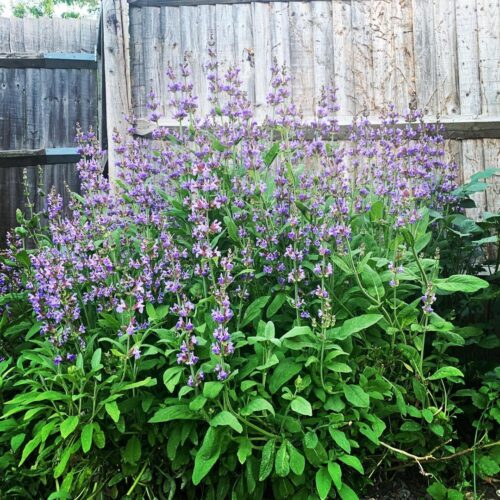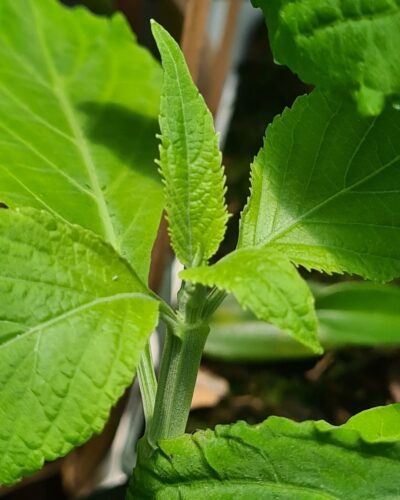Salvia Divinorum can be a distinct addition to your herb garden; grow it now by reading this comprehensive guide.
Follow this detailed article and learn about growing and caring Salvia divinorum. This herb not only looks beautiful but also has different uses. Continue to read about its requirements and propagation techniques in this post.
Common Names: Lady Salvia, Sage of the Diviners, Magic Mint, Sage of the Seers, Sally D, Diviner’s Sage, Purple Sticky
USDA Zones: 3–9
Read: Tips to Grow Krachai
Salvia Divinorum Plant Profile

Salvia Divinorum, or Sage of the Diviners, is a semi-tropical perennial herb from the southwest regions of Mexico. It features large, velvety, vivid green leaves and offers small white blooms. This plant can attain a height of up to 4-5 feet with 3-4 feet of spread.
This herb belongs to the mint family (Lamiaceae). The people of Mazatec have used it for ages for shamanic and spiritual ceremonies.
Read: Growing Cilantro in Pots
Propagating Salvia Divinorum

- You can propagate this plant from cuttings.
- Just take 4-6 inches long stem cutting below the node, remove lower leaves, and plant in a pot filled with fresh, well-draining soil.
- Water gently and cover the pot with transparent plastic; it will maintain the humidity around the plant.
- Keep the pot in a warm location with bright light. Avoid placing the plant in direct sunlight and shaded areas.
- For acclimatizing the plant to natural humidity, allow the salvia to grow in a plastic bag for a week, then for the coming 2 weeks, make two to three holes in the plastic bag; it will lower the humidity inside the bag.
- After 2 weeks, take off the plastic bag; if you notice the plant is wilting, then cover it again for a week. In case your salvia is looking healthy, it means the plant has adapted well to the humidity.
- You can transplant it into a large container.
Read: Basil Plant Care Tips
Ideal Growing Conditions for Salvia Divinorum

Light
This herb flourishes in bright, indirect light. Avoid growing this plant in areas with direct sun exposure or heavy shade.
Soil
Use well-draining soil that stays moist but does not become waterlogged. You can make a blend of perlite, peat moss, leaf mold, or compost. The ideal pH of the soil has to be slightly acidic to neutral (6.0-7.0).
Water
Keep the soil consistently moist without overwatering the plant. Maintain the soil moisture and water the plant when the topsoil turns dry between waterings.
Temperature and Humidity
Do remember Salvia divinorum appreciated warm and humid conditions. It grows well in the temperature range between 64-81 F. Protect the plant from intense heat or cold as these conditions can stress the plant.
In cool climates, move the plants indoors or protect them from cold.
Read: Betel Leaf Plant Care and Growing Guide
Salvia Divinorum Care

Fertilizer
Feed the plant regularly with a water-soluble, balanced fertilizer from spring to summer. Apply a dilute fertilizer every 2-4 weeks for a fine growth.
Note: Avoid overfeeding as it can make the plant grow leggy.
Pruning
Prune the plant in early spring or late winter before new growth develops. Remove damaged or dead branches. For dense and bushier shapes, cut excessive growth. Make a regular pruning schedule to control thin or straggling appearance.
Pests and Diseases
Salvia divinorum is vulnerable to common pests such as aphids, whiteflies, and spider mites.
Examine the plant frequently for signs of infestation; look for webbing or discolored leaves. Treat the issue by using neem oil or insecticidal soap.
Also, avoid overwatering and improve air circulation to prevent fungal diseases such as powdery mildew.
Read: Grow Ashwagandha in the Home and Garden
Salvia divinorum Facts and Uses
The most prominent feature of this plant is its psychoactive qualities. Salvia Divinorum comprises a compound salvinorin A, which can intensify hallucinogenic effects when smoked or ingested. This compound triggers kappa-opioid receptors in the brain that cause hallucinations. These effects are intense and last for 10-20 minutes.
The dry leaves of Salvia divinorum are smoked or chewed. In a few countries, it is legal but is termed controlled due to its psychedelic properties.
This herb is researched for medicinal uses to treat addictions and mood-related problems.
Warning: In many regions, the sale, consumption, and cultivation of Salvia divinorum is prohibited or governed. Hence, it is necessary to accustom yourself to risks and judicial status linked with its uses.



